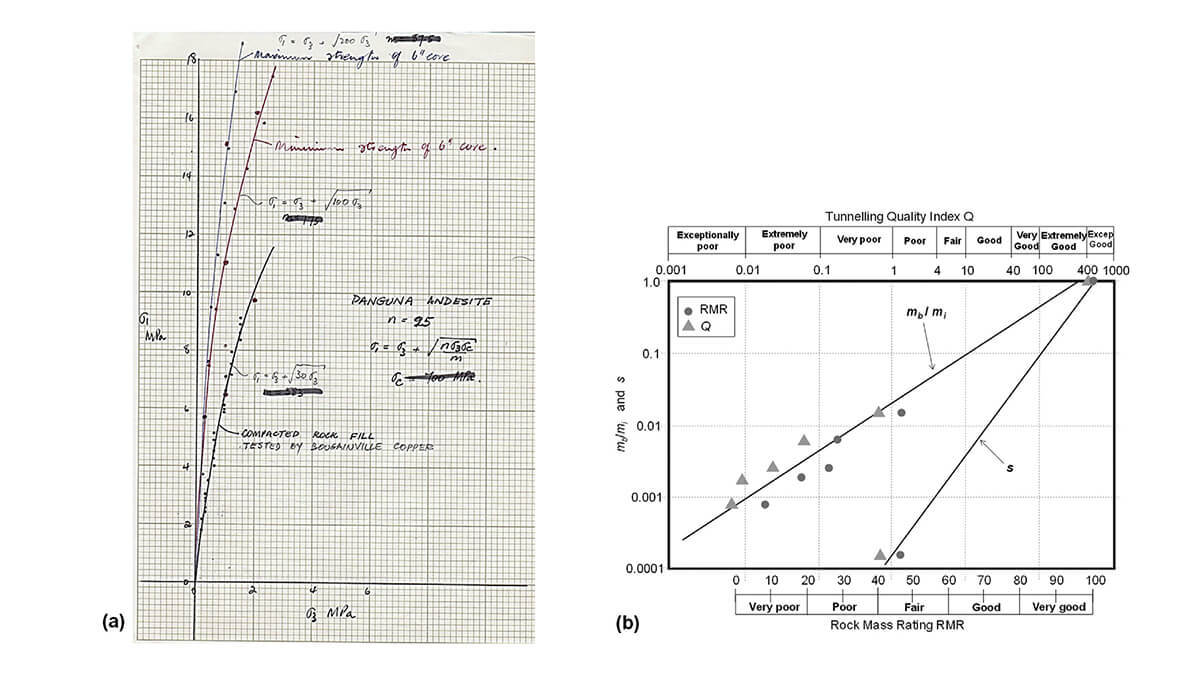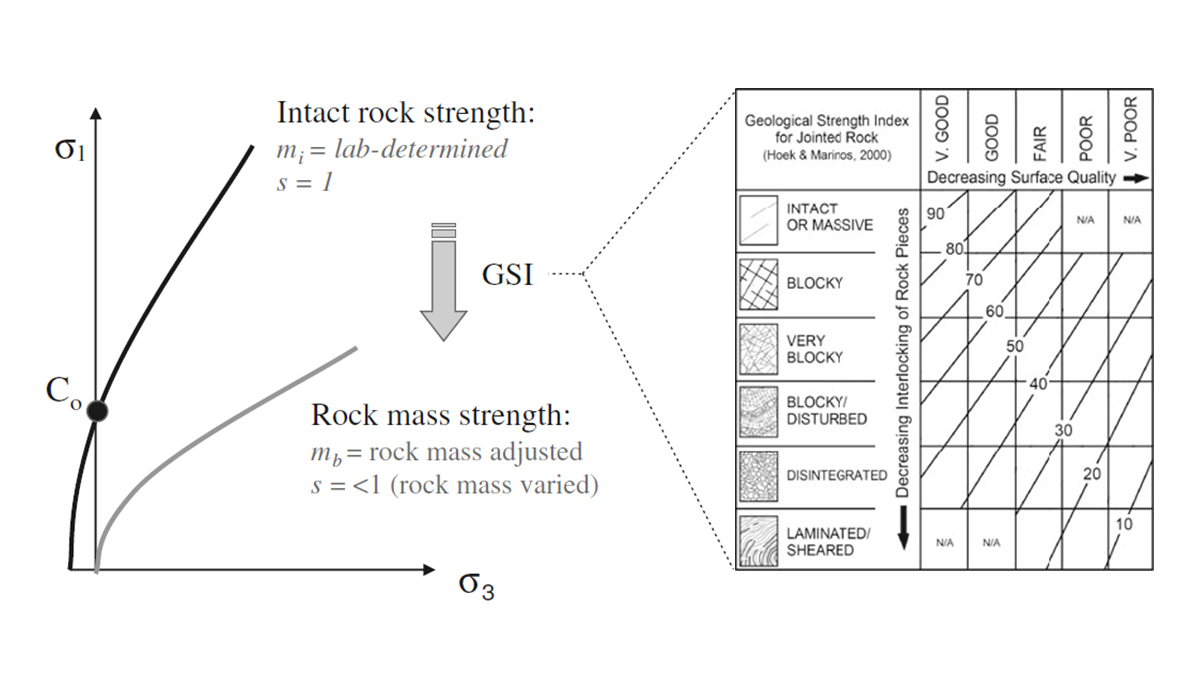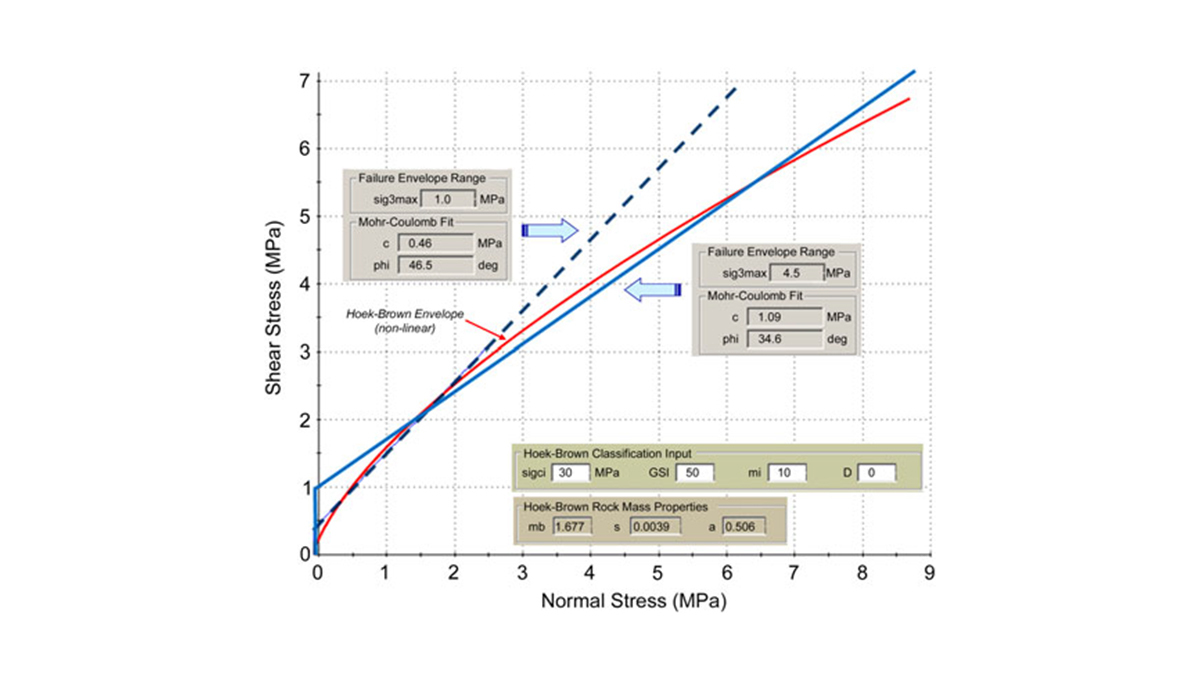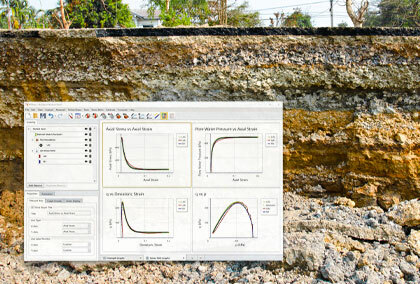The Precursor to RSData: Hoek-Brown Failure Criterion
Numerical modeling of geotechnical structures and excavations is reliant on accurate rock and soil parameters, including their strength and mass properties. Often, a lack of data can be an issue for these calculations, ultimately limiting the capabilities of geotechnical analysis.
One of the ways rock parameters can be evaluated is with the Hoek-Brown failure criterion.
History of Hoek-Brown Failure Criterion
The development of the Hoek-Brown failure criterion sought to fill in the unknowns surrounding rock mass strength by providing a dimensionless equation to connect geological observations with calculations. Observational data was in part gathered from strength tests of Panguna andesites from the Bougainville open-pit copper mine in Papua New Guinea. Some of the early calculations are shown below in Figure 1.

The failure criterion was then published by Dr. Hoek and Dr. Brown in 1980 and first used for underground excavation of hard rock with confined conditions. The original Hoek-Brown failure criterion was introduced with this equation (Figure 2) where σ1 and σ3 are the major and minor principle stresses at failure, Co is the uniaxially compressive strength of intact rock, and m and s are empirical constants depending on the type of rock.

By the late 1980’s, the Hoek-Brown failure criterion was being used globally for a variety of rock engineering problems including slope stability and surface excavations, outside of the original application of underground excavations with a hard rock mass model.
In 1992, Dr. Sandip Shah, for his Ph.D thesis at the University of Toronto, proposed a modified Hoek-Brown criterion to better estimate poor quality rock mass. By 1995, the original and modified versions were combined into a generalized failure criterion (Figure 3) to better analyze strength based on the specific quality of rock.

Around the same time, the Geological Strength Index (GSI) replaced Bieniawski’s Rock Mass Rating (RMR) as the main driver of the Hoek-Brown Failure criterion, relying more on geological observation for data input.
As the applications using the Hoek-Brown failure criterion expanded, more factors needed to be considered, which led to a re-examination of the failure criterion.
2002- Hoek-Brown Failure Criterion
The paper entitled “Hoek-Brown Failure Criterion – 2002 Edition,” aimed to address specific practical limitations that were discovered from its widespread application.
Some of the factors that were addressed were a new parameter, D, relating to blast damage being introduced to account for degree of blast damage and stress relaxation. A new relationship between m, s, a and GSI which can be seen in Figure 4. In addition, most software programs were using Mohr-Coulomb for analysis so a new equation was also introduced linking the relationship between Hoek-Brown and Mohr-Coulomb to better determine angles of friction and cohesion strength for rock mass and strength range.

The Evolution of RSData
The equations addressed by the Hoek-Brown failure criterion in 2002 gave birth to the Rocscience program RocLab, providing a convenient way to calculate and evaluate these input parameters.

RocLab, was the inspiration for our current program RocData, software built for calculating rock and soil material properties. This year, RocData is evolving into RSData, following the lead of other RS programs by improving the software for soil applications, making RSData a powerful tool for both rock and soil. Looking into the program, you will notice that the failure criterion has increased from four to eight options to better help you with your analysis.

Read about the new applications of RSData.
References:
Bahrani, N., & Kaiser, P. K. (2020). Influence of degree of interlock on confined strength of jointed hard rock masses. Journal of Rock Mechanics and Geotechnical Engineering. doi:10.1016/j.jrmge.2020.06.004
Eberhardt, E. (2012). The Hoek–Brown Failure Criterion. Rock Mechanics and Rock Engineering, 45(6), 981-988. doi:10.1007/s00603-012-0276-4
Hoek, E., & Marinos, P. (2006). A brief history of the development of the Hoek-Brown failure criterion.
Hoek, E., Carranza-Torres, C., & Corkum, B. (2002). HOEK-BROWN FAILURE CRITERION – 2002 EDITION.


